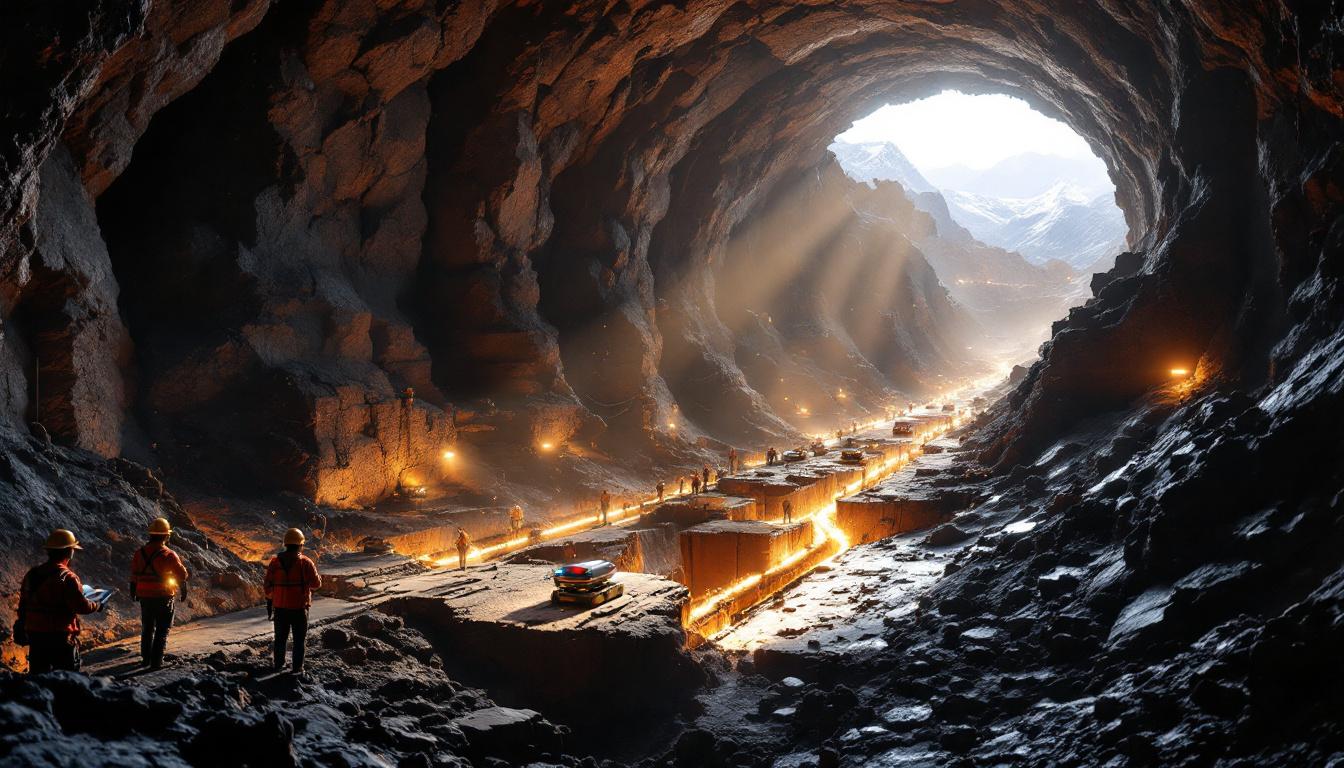What is the Salares Altoandinos Lithium Project?
A World-Class Lithium Development in Chile's Atacama Region
The Salares Altoandinos project represents a significant lithium development located in Chile's mineral-rich Atacama region, situated within South America's renowned "Lithium Triangle." This strategic asset has been identified by Rio Tinto as having world-class potential, positioning it as a crucial component in the global lithium supply chain.
Geologically, the project benefits from being located in one of the world's most productive lithium-bearing regions. The Atacama's unique combination of high solar radiation, low precipitation, and lithium-rich brine deposits creates ideal conditions for efficient lithium brine extraction. Industry experts have consistently ranked Chile's Atacama salars among the highest-grade and lowest-cost lithium resources globally.
The Strategic Partnership Structure
Under the recently announced partnership agreement, Rio Tinto will acquire an initial 51% controlling stake in the Salares Altoandinos project, while ENAMI (Empresa Nacional de Minería), Chile's state-owned mining company, will retain the remaining 49%.
This ownership structure reflects Chile's balanced approach to strategic mineral resource development—encouraging foreign investment and technical expertise while maintaining significant national interest in critical minerals. As Rio Tinto CEO Jakob Stausholm noted: "We are honoured to have been selected by ENAMI as the preferred partner for the Salares Altoandinos project, which has the potential to be a world-class lithium development."
The transaction remains subject to binding agreements, regulatory approvals from Chilean authorities, and other customary closing conditions. This partnership builds upon Rio Tinto's existing relationships in Chile, including their partnerships at Nuevo Cobre and the Salar de Maricunga.
Why is Rio Tinto Investing in Chilean Lithium?
Building a Global Lithium Portfolio
Rio Tinto is strategically positioning itself as a global leader in energy transition commodities, with lithium forming a cornerstone of this energy transition strategy. The company's $10-11 billion annual capital expenditure guidance underscores the significance of their commitment to expanding their presence in critical minerals markets.
The Salares Altoandinos project represents an important addition to Rio Tinto's rapidly expanding lithium portfolio, which has been significantly strengthened by the recent acquisition of Arcadium Lithium. This acquisition has provided Rio Tinto with one of the world's largest and most diverse lithium asset portfolios, enabling them to become a major player in the battery materials supply chain.
With 28 years of experience in Direct Lithium Extraction (DLE) technologies, Rio Tinto brings substantial technical expertise to lithium development. This experience provides a competitive advantage in developing more environmentally sustainable extraction methods compared to traditional evaporation pond techniques.
South American Expansion Strategy
The Salares Altoandinos project is part of Rio Tinto's broader South American lithium strategy, which includes:
- In Chile: The new ENAMI partnership at Salares Altoandinos and a separate partnership with Codelco at Salar de Maricunga
- In Argentina: Multiple projects including Rincon, Olaroz, Fenix, Sal de Vida, and Cauchari
This expanding South American pipeline complements Rio Tinto's existing lithium projects in Canada and Serbia, creating a globally diversified lithium production base. The strategy allows Rio Tinto to leverage regional expertise, infrastructure, and relationships while mitigating geopolitical and operational risks through geographic diversification.
How Does This Project Fit into the Global Lithium Market?
Long-Term Market Outlook and Strategic Timing
Rio Tinto's investment comes at a strategic time in the lithium market cycle. According to data cited from Benchmark Mineral Intelligence (BMI) as of September 2024, the company anticipates:
- A compound annual growth rate for lithium demand exceeding 10% through 2040
- A market deficit emerging from the end of this decade
- Current spot lithium prices down more than 80% from peak levels
This counter-cyclical investment approach allows Rio Tinto to acquire and develop lithium assets during a period of relatively depressed prices, positioning the company for substantial returns when the projected supply deficit materializes. Industry analysts note that while near-term lithium market downturn remains a challenge, the medium to long-term outlook remains extremely robust due to accelerating electric vehicle adoption globally.
"These additions to the portfolio come at a time with substantial long-term market and portfolio upside," Rio Tinto stated in their announcement, highlighting the strategic timing of their expansion.
Competitive Advantages in the Lithium Triangle
Rio Tinto brings several competitive advantages to lithium development in South America:
| Advantage | Description |
|---|---|
| Regional Footprint | Established presence in the Lithium Triangle enabling operational synergies |
| Financial Strength | Strong balance sheet with $10-11 billion annual capex guidance |
| Technological Expertise | 28 years of Direct Lithium Extraction (DLE) experience |
| Operational Excellence | "Best Operator" approach focusing on efficiency and innovation |
| Project Delivery | Proven track record in exploration and complex project development |
| ESG Credentials | Commitment to community engagement, water conservation, and environmental protection |
The company's financial resources allow it to develop multiple projects simultaneously while withstanding market volatility. Their technical capabilities in DLE technology provide a significant advantage in addressing environmental concerns typically associated with traditional lithium production methods.
What Operational Approach Will Rio Tinto Take?
Developing an Integrated Lithium District
In Chile, Rio Tinto aims to develop a world-class copper and lithium district in the Atacama region, leveraging potential synergies through its various partnerships. This integrated approach allows for shared infrastructure, coordinated community engagement, and technical knowledge transfer between projects.
The company envisions creating operational "super-hubs" in Argentina that will achieve significant scale and competitive advantages through:
- Investments in shared infrastructure (power, logistics, processing)
- Coordinated community engagement approaches
- Minimized freshwater consumption through recycling technologies
- Advanced processing and re-injection technologies
This hub-based approach represents a departure from the traditional standalone project development model in the mining industry, potentially delivering substantial operational and cost efficiencies while reducing environmental impacts.
Environmental and Social Considerations
Rio Tinto has emphasized several key sustainability commitments for its lithium operations:
- Deep engagement with local communities and indigenous peoples
- Minimizing freshwater consumption in water-sensitive regions like the Atacama
- Commitment to brine reinjection studies to reduce environmental impacts
- Maximizing lithium recovery while minimizing environmental footprint
Water management is particularly critical in Chile's Atacama region, one of the driest deserts in the world. The company's focus on water conservation technologies and brine reinjection studies reflects the heightened environmental scrutiny facing lithium producers in these sensitive ecosystems.
Rio Tinto's adoption of DLE technology is central to its environmental strategy. Unlike traditional evaporation pond methods that can take 18-24 months to produce lithium and have significant land and water impacts, DLE can extract lithium in hours or days with a smaller physical footprint and potentially higher recovery rates.
What Does This Mean for Chile's Mining Sector?
Strengthening Chile's Position in Critical Minerals
The partnership between Rio Tinto and ENAMI represents an important development for Chile's mining sector. As noted by Rio Tinto CEO Jakob Stausholm, the project will "support Chile's position as one of the world's leading producers of minerals critical to the energy transition."
Chile has historically dominated global lithium production along with Australia, but has faced increasing competition in recent years from other producers. This partnership signals Chile's continued commitment to maintaining its leadership position in the lithium market while adapting its traditional state-controlled approach to accommodate foreign investment and expertise.
The 51/49 ownership structure reflects Chile's evolving approach to natural resource development—balancing national interests through ENAMI's significant stake while attracting the capital and technical expertise of major international mining companies like Rio Tinto.
Building on Existing Relationships
The Salares Altoandinos project builds upon Rio Tinto's existing interests in Chile, including partnerships at Nuevo Cobre and Salar de Maricunga. This expanded presence indicates growing confidence in Chile as a mining jurisdiction and potentially signals further investment in the country's mineral resources.
For Chile's mining sector more broadly, the partnership represents an opportunity to diversify beyond the country's traditional focus on copper production. While Chile remains the world's largest copper producer, the development of its lithium resources provides an important avenue for growth and economic diversification as global demand for battery materials accelerates.
How Does This Fit into Rio Tinto's Broader Strategy?
Diversification into Energy Transition Minerals
The Salares Altoandinos project represents part of Rio Tinto's strategic pivot toward energy transition minerals. While traditionally known for iron ore, copper, and aluminum, the company is actively diversifying its portfolio to include minerals essential for renewable energy technologies and electric vehicles.
This strategy positions Rio Tinto to benefit from structural changes in global commodity markets driven by decarbonization efforts and electrification trends. The company's approach combines leveraging existing operational expertise with acquiring new capabilities specifically relevant to battery materials and other critical minerals.
Unlike some competitors who are pursuing vertical integration into battery manufacturing, Rio Tinto appears focused on becoming a premier upstream supplier of high-quality lithium products to battery manufacturers and automakers. This approach leverages the company's core competencies in resource development and large-scale mining operations.
Global Lithium Footprint Expansion
Rio Tinto continues to evaluate Tier 1 lithium opportunities globally as it builds momentum in its lithium business. The company's approach combines:
- Strategic acquisitions (like Arcadium Lithium)
- Joint ventures with established local partners
- Organic project development
- Technology investments to improve extraction efficiency
This multi-pronged approach allows Rio Tinto to accelerate its entry into the lithium market while managing development risks. The geographic diversification across multiple continents provides portfolio resilience against country-specific regulatory or operational challenges.
The focus on high-quality, low-cost assets like those in Chile's Atacama region aligns with Rio Tinto's traditional emphasis on developing tier-one resources that can deliver sustainable returns throughout commodity price cycles.
What Are the Next Steps for the Project?
Regulatory and Development Timeline
While specific development timelines haven't been disclosed, the Salares Altoandinos project must progress through several key stages:
- Finalization of binding agreements between Rio Tinto and ENAMI
- Securing regulatory approvals from Chilean authorities
- Completion of technical and feasibility studies
- Final investment decisions and project financing
- Construction and commissioning
Chilean mining projects typically undergo rigorous environmental impact assessments and community consultation processes, which can extend development timelines. However, Rio Tinto's existing relationships with Chilean authorities and experience with similar projects may help streamline these processes.
Integration with Existing Operations
A key focus will be integrating the Salares Altoandinos project with Rio Tinto's existing South American operations to maximize operational synergies and efficiency. This may include:
- Shared infrastructure development between multiple projects
- Coordinated logistics and transportation networks
- Knowledge sharing between technical teams
- Standardized approaches to environmental management
- Consistent community engagement practices
This integration strategy is central to Rio Tinto's "super-hub" concept, which aims to create operational clusters that deliver economies of scale and competitive advantages that wouldn't be possible with standalone project development.
FAQ About Rio Tinto's Lithium Strategy
What is Direct Lithium Extraction (DLE) technology?
Direct Lithium Extraction is an advanced technology that allows for more efficient extraction of lithium from brine resources compared to traditional evaporation ponds. Rio Tinto has 28 years of experience with DLE technologies, which typically offer:
- Reduced environmental footprint (smaller land area requirements)
- Higher recovery rates (potentially 70-90% vs. 30-50% for evaporation ponds)
- Faster production timelines (hours/days vs. 18-24 months)
- Reduced freshwater consumption
- Potential for brine reinjection after lithium extraction
While various DLE technologies exist, they generally involve selective adsorption, ion exchange, or membrane processes that can extract lithium directly from brines without extensive evaporation. Rio Tinto's experience with these technologies provides a competitive advantage in addressing environmental concerns while potentially lowering production costs.
How does the lithium market outlook influence Rio Tinto's strategy?
Rio Tinto anticipates a compound annual growth rate exceeding 10% for lithium demand through 2040, driven primarily by electric vehicle battery production. With current prices significantly below peak levels (down more than 80%), the company sees this as an opportune time to expand its lithium portfolio ahead of projected market deficits expected to emerge from the end of this decade.
This counter-cyclical investment approach aligns with Rio Tinto's traditional strategy of acquiring and developing high-quality assets during market downturns. The company's strong balance sheet enables it to make substantial investments despite current market conditions, positioning it to benefit when lithium markets inevitably tighten.
The long-term structural demand growth for lithium is supported by global electrification trends, including:
- Electric vehicle adoption targets by major automakers
- Grid-scale energy storage deployment
- Consumer electronics with increasingly powerful batteries
- Government policies supporting decarbonization
What environmental considerations are important for lithium projects in Chile?
Water usage is a critical concern in Chile's Atacama region, which is one of the driest deserts in the world. Rio Tinto has emphasized commitments to:
- Minimizing freshwater consumption through recycling
- Studying brine reinjection techniques
- Implementing technologies that reduce environmental impacts
- Engaging with local communities on water management
The Atacama ecosystem is particularly sensitive to hydrological changes, and there are ongoing scientific debates about the potential impacts of lithium extraction on local flamingo populations and other wildlife that depend on the unique salt flat ecosystems.
Rio Tinto's emphasis on DLE technology partly addresses these concerns by potentially reducing evaporation losses and enabling brine reinjection, which could help maintain hydrological balance in these sensitive environments.
How does this project compare to other major lithium developments globally?
While specific production targets haven't been disclosed, the Salares Altoandinos project has been described as having "world-class" potential. Chile's Atacama region is known for hosting some of the world's highest-grade and lowest-cost lithium resources, suggesting this project could be competitively positioned in the global cost curve.
Compared to hard-rock lithium projects (spodumene) in Australia or North America, brine-based projects in the Lithium Triangle typically benefit from:
- Lower operating costs
- Higher lithium concentration in the resource
- Lower energy requirements for extraction
- Potential for byproduct credits (potassium, boron, etc.)
However, brine projects generally have higher upfront capital requirements and longer development timelines compared to some hard-rock operations. Rio Tinto's financial strength and patient capital approach position it well to develop these longer-lead-time, higher-return projects.
Key Takeaways: Rio Tinto and the Salares Altoandinos Project
| Aspect | Details |
|---|---|
| Partnership Structure | Rio Tinto (51%), ENAMI (49%) |
| Location | Atacama region, Chile |
| Strategic Significance | Addition to Rio Tinto's growing lithium portfolio |
| Market Context | Positioned for projected >10% annual demand growth through 2040 |
| Competitive Advantages | Financial strength, DLE expertise, operational excellence |
| Environmental Approach | Focus on water conservation, brine reinjection studies |
| Development Status | Selected as preferred partner; binding agreements pending |
Further Exploration:
Readers interested in learning more about Rio Tinto's lithium strategy can also explore related educational content about Argentina lithium insights and innovative lithium developments in the industry.
Want to Identify the Next Major Mineral Discovery?
Discovery Alert's proprietary Discovery IQ model instantly notifies investors about significant ASX mineral discoveries, turning complex data into actionable investment insights. Explore how historic discoveries have generated substantial returns by visiting Discovery Alert's dedicated discoveries page and position yourself ahead of the market.




